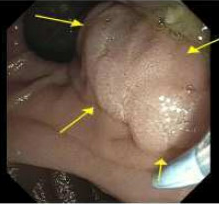Tuesday Poster Session
Category: Biliary/Pancreas
P4516 - Dual Structural Abnormalities in the Periampullary Region Causing Acute Pancreatitis: A Case Report
Tuesday, October 28, 2025
10:30 AM - 4:00 PM PDT
Location: Exhibit Hall

Fawad Talat, MD
United Health Services, Wilson Medical Center
Johnson City, NY
Presenting Author(s)
Fawad Talat, MD1, Abdul Subhan Talpur, MD1, Hammad Qadri, DO2, Hamza Usman, MD1, Moheudin Khan, MD1, Ailsa Lee, MD1, Joseph Jones, MD1, Ibrar Atiq, MD1
1United Health Services, Wilson Medical Center, Johnson City, NY; 2United Health Services, Wilson Medical Center, Vestal, NY
Introduction: Juxtapapillary duodenal diverticula (JDD) and ampullary adenomas are both uncommon causes of pancreatitis; they rarely co-occur together. We present a case that highlights the challenge of identifying this dual pathology.
Case Description/
Methods: A 69-year-old female with a medical history of paroxysmal atrial fibrillation, hypertension, hyperlipidemia, stage V chronic kidney disease, and ischemic stroke presented with acute onset nausea and severe abdominal pain. The pain was localized to the right upper quadrant and epigastrium, radiating to the back, with an intensity of 8/10. She denied any alcohol use or prior episodes of pancreatitis. On examination, epigastric and RUQ tenderness were noted. Lab work showed lipase > 4,000 U/L, AST 102 U/L, ALT 55 U/L, WBC 13.3 × 10⁹/L, BUN 50 mg/dL, and creatinine 3.4 mg/dL. Management was started in the lines of acute pancreatitis.
Initial imaging with non-contrast CT of the abdomen and pelvis showed an enlarged gallbladder but no evidence of pancreatitis or cholelithiasis. The RUQ ultrasound showed no evidence of cholecystitis but showed an enlarged common bile duct (11.8 mm). MRCP revealed a 4 × 3 mm filling defect in the distal CBD. ERCP showed no signs of choledocholithiasis, but rather a broad-based ampullary adenoma covering a juxtapapillary diverticulum. Endoscopic ampullectomy was performed with placement of biliary and pancreatic duct stents. Following the procedure, lipase and abdominal pain returned to normal, indicating ampullary adenoma and JDD as the etiology of patient's pancreatitis.
Discussion: Juxtapapillary duodenal diverticula are observed in up to 21% of adults, with 70–75% located periampullary. Although typically asymptomatic, JDD can result in pancreatitis through dysfunction of ampulla or compression of CBD. Ampullary adenoma, which is a premalignant lesion of duodenal papilla, can cause pancreatitis by blocking the pancreatic duct, though it is also rare. In this case, both lesions are present at the same time, increasing the obstructive risk and consequently the risk of pancreatitis. To date, only a few similar cases have been reported, making this an exceptional example of dual pathology leading to acute pancreatitis. When early tests fail to detect common causes of pancreatitis, this case highlights the importance of advanced endoscopy and biliary imaging.

Figure: Endoscopic image showing periampullary adenoma

Figure: Endoscopic image showing periampullary adenoma and juxtapapillary diverticulum
Disclosures:
Fawad Talat indicated no relevant financial relationships.
Abdul Subhan Talpur indicated no relevant financial relationships.
Hammad Qadri indicated no relevant financial relationships.
Hamza Usman indicated no relevant financial relationships.
Moheudin Khan indicated no relevant financial relationships.
Ailsa Lee indicated no relevant financial relationships.
Joseph Jones indicated no relevant financial relationships.
Ibrar Atiq indicated no relevant financial relationships.
Fawad Talat, MD1, Abdul Subhan Talpur, MD1, Hammad Qadri, DO2, Hamza Usman, MD1, Moheudin Khan, MD1, Ailsa Lee, MD1, Joseph Jones, MD1, Ibrar Atiq, MD1. P4516 - Dual Structural Abnormalities in the Periampullary Region Causing Acute Pancreatitis: A Case Report, ACG 2025 Annual Scientific Meeting Abstracts. Phoenix, AZ: American College of Gastroenterology.
1United Health Services, Wilson Medical Center, Johnson City, NY; 2United Health Services, Wilson Medical Center, Vestal, NY
Introduction: Juxtapapillary duodenal diverticula (JDD) and ampullary adenomas are both uncommon causes of pancreatitis; they rarely co-occur together. We present a case that highlights the challenge of identifying this dual pathology.
Case Description/
Methods: A 69-year-old female with a medical history of paroxysmal atrial fibrillation, hypertension, hyperlipidemia, stage V chronic kidney disease, and ischemic stroke presented with acute onset nausea and severe abdominal pain. The pain was localized to the right upper quadrant and epigastrium, radiating to the back, with an intensity of 8/10. She denied any alcohol use or prior episodes of pancreatitis. On examination, epigastric and RUQ tenderness were noted. Lab work showed lipase > 4,000 U/L, AST 102 U/L, ALT 55 U/L, WBC 13.3 × 10⁹/L, BUN 50 mg/dL, and creatinine 3.4 mg/dL. Management was started in the lines of acute pancreatitis.
Initial imaging with non-contrast CT of the abdomen and pelvis showed an enlarged gallbladder but no evidence of pancreatitis or cholelithiasis. The RUQ ultrasound showed no evidence of cholecystitis but showed an enlarged common bile duct (11.8 mm). MRCP revealed a 4 × 3 mm filling defect in the distal CBD. ERCP showed no signs of choledocholithiasis, but rather a broad-based ampullary adenoma covering a juxtapapillary diverticulum. Endoscopic ampullectomy was performed with placement of biliary and pancreatic duct stents. Following the procedure, lipase and abdominal pain returned to normal, indicating ampullary adenoma and JDD as the etiology of patient's pancreatitis.
Discussion: Juxtapapillary duodenal diverticula are observed in up to 21% of adults, with 70–75% located periampullary. Although typically asymptomatic, JDD can result in pancreatitis through dysfunction of ampulla or compression of CBD. Ampullary adenoma, which is a premalignant lesion of duodenal papilla, can cause pancreatitis by blocking the pancreatic duct, though it is also rare. In this case, both lesions are present at the same time, increasing the obstructive risk and consequently the risk of pancreatitis. To date, only a few similar cases have been reported, making this an exceptional example of dual pathology leading to acute pancreatitis. When early tests fail to detect common causes of pancreatitis, this case highlights the importance of advanced endoscopy and biliary imaging.

Figure: Endoscopic image showing periampullary adenoma

Figure: Endoscopic image showing periampullary adenoma and juxtapapillary diverticulum
Disclosures:
Fawad Talat indicated no relevant financial relationships.
Abdul Subhan Talpur indicated no relevant financial relationships.
Hammad Qadri indicated no relevant financial relationships.
Hamza Usman indicated no relevant financial relationships.
Moheudin Khan indicated no relevant financial relationships.
Ailsa Lee indicated no relevant financial relationships.
Joseph Jones indicated no relevant financial relationships.
Ibrar Atiq indicated no relevant financial relationships.
Fawad Talat, MD1, Abdul Subhan Talpur, MD1, Hammad Qadri, DO2, Hamza Usman, MD1, Moheudin Khan, MD1, Ailsa Lee, MD1, Joseph Jones, MD1, Ibrar Atiq, MD1. P4516 - Dual Structural Abnormalities in the Periampullary Region Causing Acute Pancreatitis: A Case Report, ACG 2025 Annual Scientific Meeting Abstracts. Phoenix, AZ: American College of Gastroenterology.
